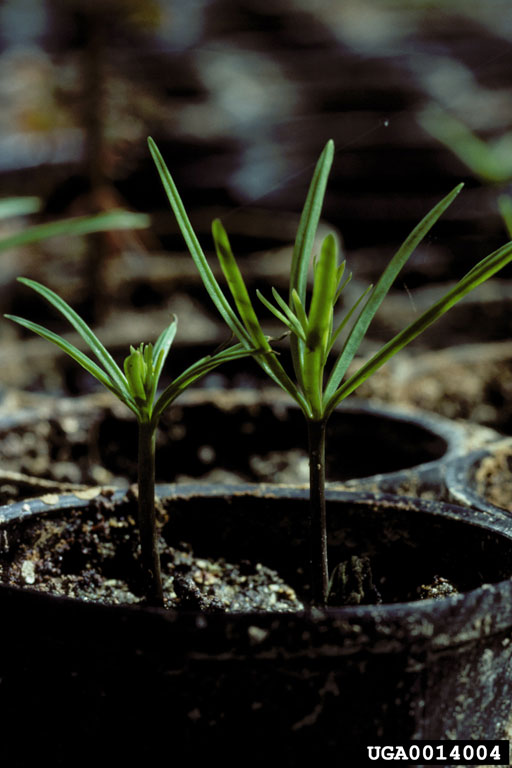 Growing Native Trees from Seed - December 18, 2013 Jeff Schalau, Agent, Agriculture & Natural Resources University of Arizona Cooperative Extension, Yavapai County Many of our treasured native trees can be grown from seed. Some seeds require exposure to cold moist conditions, physical abrasion or the acidic conditions of an animal’s gut to germinate. Think about it…without these adaptations, they may germinate at the wrong time of year and be killed by frost, heat, drought, hungry predators, or pathogens. The individuals that survive these ordeals are best suited to their environment. Almost all tree seeds require some “treatment” to break dormancy. Stratification is the most common. Stratification is a period of exposure to moist, cold (33 to 41 degrees F) conditions for a specified period of time (1 to 6 months). In species that require stratification, the treatment causes gradual and progressive internal physiological changes that lead to more successful germination. Simply put, stratification mimics a cold, damp winter. Commercial producers use specialized equipment, but at home you can usually stratify seed by wrapping them in a moist (not dripping wet) paper towel inside a closed plastic bag with a few small holes poked in it and placing it in a corner of your refrigerator. A damp sand/peat moss mixture can be substituted for the paper towels if desired. Do not be alarmed by mold growth is visible. Just keep the contents of the bag moist and check for germinating seeds periodically. Some plants have hard seed coats that physically prevent germination by simply not allowing moisture to enter the seed. For these species, a nick in the seed coat with a file or sandpaper will increase germination. Sometimes heat is also used, especially in fire-adapted species. These techniques are called scarification. Commercial producers often used sulfuric acid to scarify large quantities of seed. Once germinated, many tree species can be grown in pots until transplanting. However, some species will do best when grown directly in native soil (or elongated containers – see link below), which allows them to put down deep roots following germination. Oaks, walnuts, and other large seeded plants often fall into this category. Seeds grown in native soil will also require less frequent watering. They may also require some protection from herbivores (rabbits, deer, etc.). Given this small amount of background information, I will provide some guidelines for germinating some of my favorite tree species. You may also just try a few different techniques to experiment on your own. Arizona ash (Fraxinus velutina). Stratify for 90 days and sow covering with ¼ to ¾ inch of soil. Shading of the germinated seedling for a week or two may be desirable. Arizona cypress (Cupressus arizonica). Cut mature, two year-old cones from tree and allow to air dry until scales separate. Seed will fall out of cone. Stratify for 21 days and sow covering with less than ¼ inch of soil. Arizona sycamore (Platanus wrightii). Stratify for 60 to 90 days and sow covering with ¼ inch of soil or mulch. Protect from birds and small mammals. Arizona sycamore grows to become a large tree and requires moderate to frequent irrigation. Desert willow (Chilopsis linearis). Harvest mature seedpods just before pods open. Lay pods out to dry and collect seed when pods open. No stratification is necessary, but storage in wet sand for several days speeds germination. Sow ¼ inch deep. Netleaf hackberry (Celtis reticulata). Harvest mature fruits and remove flesh by soaking in water and rubbing against a screen (this process is called wet maceration). Stratify for 60 to 90 days and sow covering with ½ inch of firmed soil. Protect from birds and small mammals. Velvet mesquite (Prosopis velutina). Harvest mature seedpods just before pods open. Allow to dry then crush to extract seed. Many of the seeds will be likely be killed by Bruchid beetles (weevils that make small holes in seeds). Scarify seeds by nicking with a single edge razor or knife. Sow covering with ¼ inch soil. Western soapberry (Sapindus drummondii). Harvest mature fruits in fall and remove flesh by soaking in water and screening. Stratify seed for 90 days and sow covering with ¾ inch of firmed soil. Germination may also be enhanced by scarification. Below, I have included a links to the 916 page volume Seeds of Woody Plants of the United States (which includes seed germination methods for many species) and a forestry supply website that markets an assortment of tree nursery containers. Follow the Backyard Gardener on Twitter – use the link on the BYG website. If you have other gardening questions, call the Master Gardener help line in the Camp Verde office at 928-554-8999 Ext. 3 or e-mail us at cottonwoodmg@yahoo.com and be sure to include your name, address and phone number. Find past Backyard Gardener columns or provide feedback at the Backyard Gardener web site: http://cals.arizona.edu/yavapai/anr/hort/byg/. Additional Resources Seeds of Woody Plants in the United States, Forest Service Handbook, USDA Agriculture Handbook No. 450, 1974 You may view or download the book by choosing an option in the box on the upper left - this is a large file and will require some time to download. https://archive.org/details/seedsofwoodyplan00fore Stuewe & Sons Inc.: Tree Seedling Nursery Containers, Tangent, Oregon Naming of companies or products is neither meant to imply endorsement by the author nor criticism of similar companies or products not mentioned. http://www.stuewe.com/ |